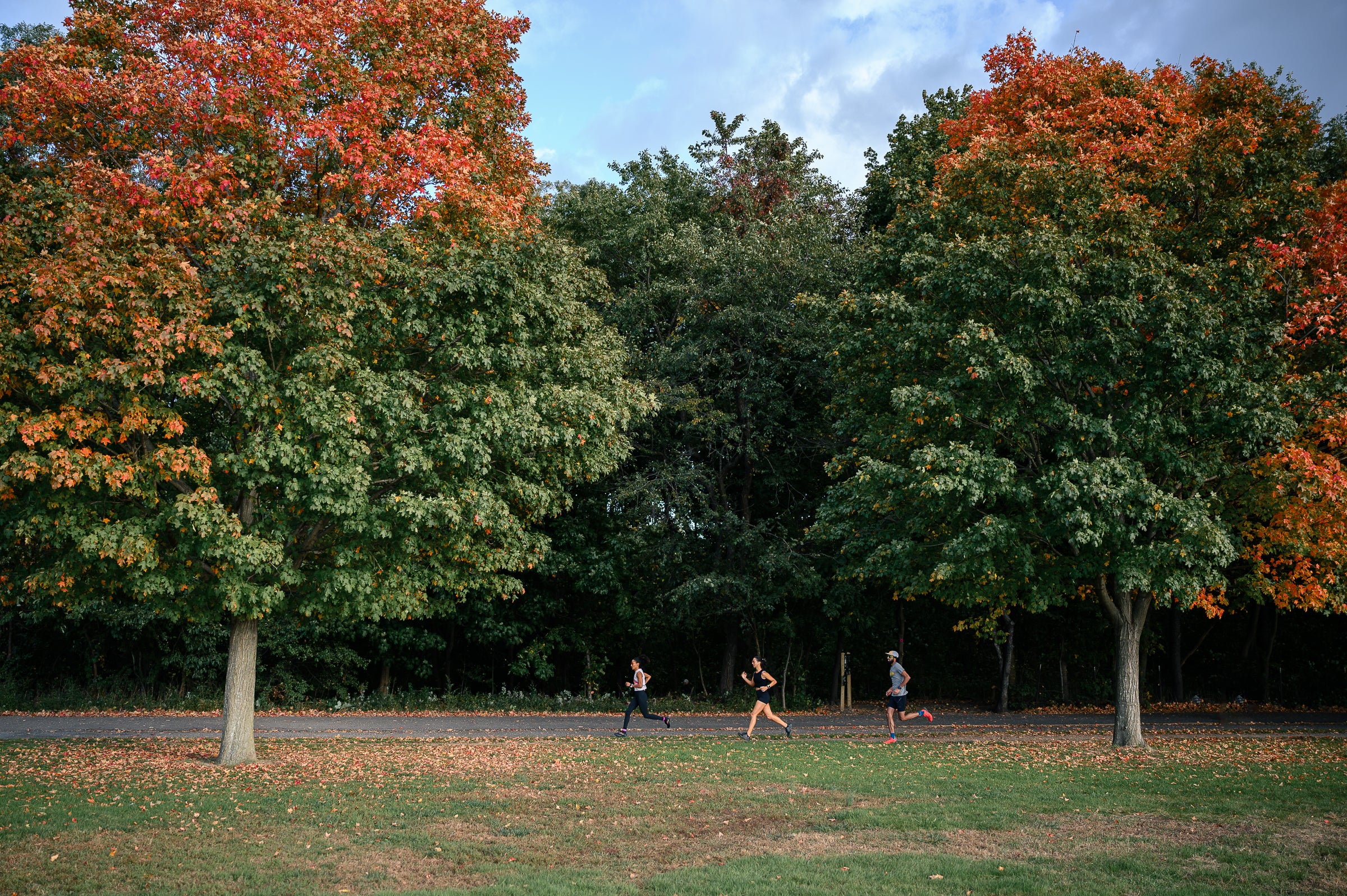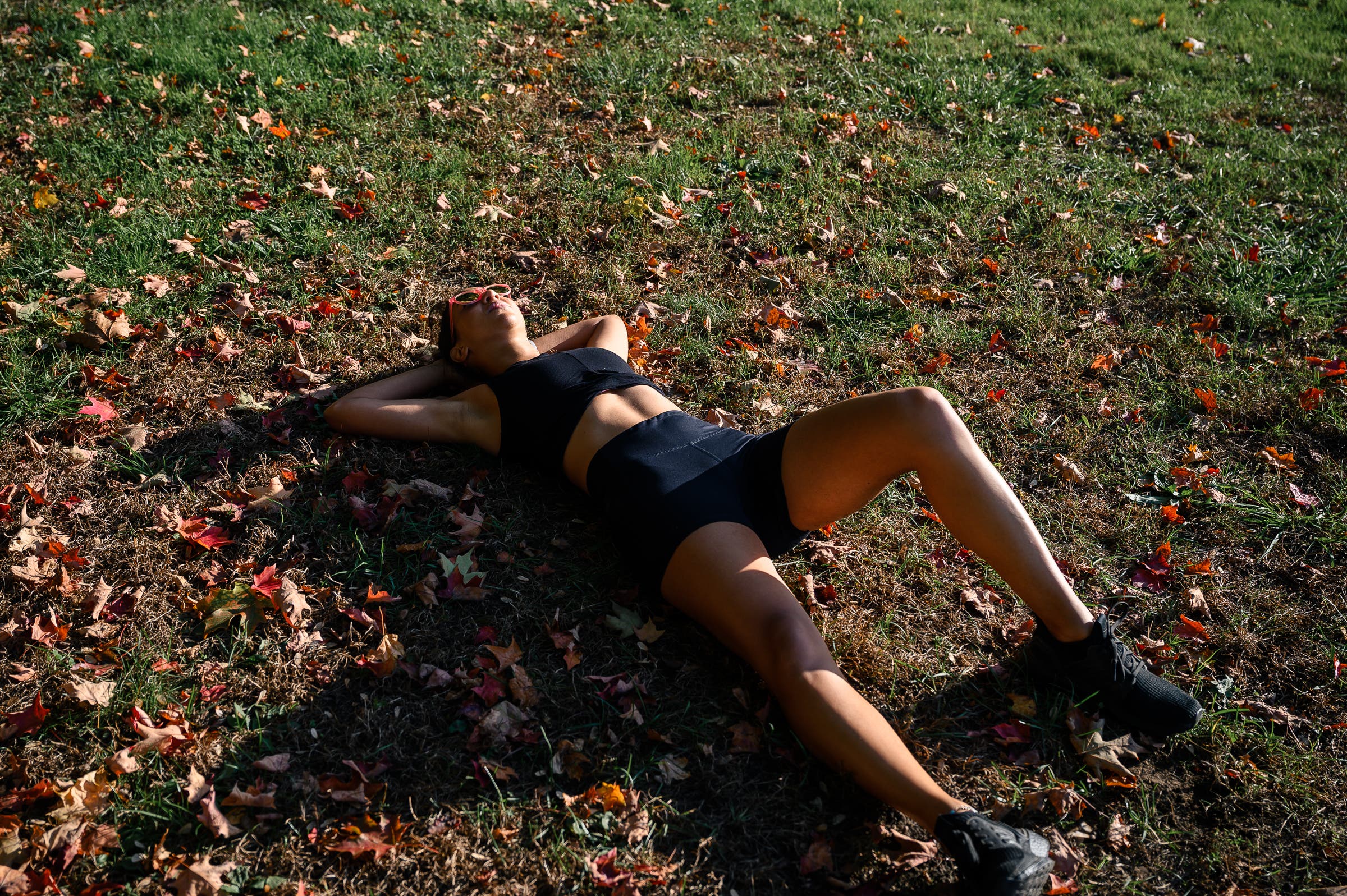Your Five-Minute Stress Fracture Gratitude Meditation

(Photo: Johnny Zhang)
If you clicked in to read this story, chances are you’re either currently injured – like me – or you have been. If we train and run for long enough, eventually the majority of us will deal with at least a minor injury. If that injury is severe enough to take a forced break from running, you might feel a bit like a squirrel trapped in a small cage. I know I do.
As I type these words, I’m sitting on my couch under a throw blanket with a walking boot on my right foot. I’m eating the Girl Scout Cookies I bought three days ago, and one of the boxes is already empty. My dog is giving me a judgmental side-eye, wondering why her walks have gotten so slow and short lately. I’m trying to work up the gumption to go get a workout done in the pool, but the Thin Mints are making a much more convincing argument.
I’m exactly two weeks into my time in the walking boot, but once it comes off, I still won’t be able to run for a while, let alone return to my pre-injury training. I’m in the process of healing a metatarsal stress fracture, the result of an accidental ankle roll during a recent icy run.
So for now, I am relegated to 100% non-impact exercise. I can’t even sweat it out on a stationary bike. It’s all swimming and pool running and something called “chair cardio.” (All harder than they have any right to be.) It’s also been crying and sleeping and binging the new seasons of Love is Blind and Bridgerton on Netflix with my boyfriend.
Getting an injury diagnosed is a process that can – and usually does – lead to a maelstrom of conflicting feelings. Mine began with looming dread, which evolved into worry, which led to resignation as my podiatrist read my X-rays, then numbness, then rage, then despondence, then extreme boredom. And then, there was gratitude.
I’m not grateful to have rolled my ankle and cracked my foot bone. I would have avoided that if I could have in the moment. But, the forced change in my routine and lifestyle, while only temporary, is teaching me a lot about myself, and has led to four thunderbolts of self-examination that I likely wouldn’t have experienced otherwise.
1. If running is your entire identity, that might not be a healthy approach.
When I first got my fracture diagnosed, my thoughts immediately went to the races I had planned for the year, the closest of which was only two weeks away. After I angrily scratched that one off the calendar, I started calculating what weeks of missed training would do to my goals, trying to figure out if I could simply jump into the later stages of my training plan once I was cleared to run again. I’d had specific time and distance goals written down in my training log for months: what did it mean for my worth as a person if I could no longer reach them?
I felt immediately like a failure. Only bad runners get injured, my brain said. Only weak people get stress fractures. This happened to you because you ran wrong. I saw other people out running through my neighborhood and Brain told me they were better than me, because they could run. They hadn’t managed to break themselves.
I was willing to do more damage rather than take the time required to come back stronger and healthier later. The realization shocked me into re-evaluating why I run at all.
While I still have trouble saying this to the runner in the mirror, none of those things are true. Can mistakes lead to injury? Sure. But everyone, from the fastest athletes in the world to the brand new first-timer, deals with injury. It’s simply a part of being. I don’t know anything about the runners I see on my neighborhood sidewalks and trails. But Brain created a hierarchy in which they were above me, based on one very small part of our identity as humans: our athletic hobby.
RELATED: Deciding When Not To Run
I listened to those thoughts and realized that if someone else had said them to me – or worse, if I said them to someone else – they would sound completely different. It was then that I realized the voice in my head had far more power with negative thoughts than positive ones, and that the amount of self-worth I drew purely from running might be a little off-balance.

2. An injury is your body telling you it needs something.
While some injuries come from freak accidents or pure chance, most often there’s a reason they happen. It takes work with coaches and medical professionals to figure out what those reasons might be, but they can include a range of factors: not warming up properly, not fueling enough, increasing mileage too quickly, lack of sleep, nutrient deficiency, or any number of other issues.
It took the non-runners in my life to point out the fact that my thinking was out of whack. Becoming injured only to immediately begin obsessing about healing it as quickly as possible wasn’t going to help me, and it wouldn’t keep me healthy for very long. If I wanted to avoid surgical fixes or repeat injuries, I needed to take a closer look at all aspects of my training and identify what factors contributed to the injury in the first place.
I realized the voice in my head had far more power with negative thoughts than positive ones, and that the amount of self-worth I drew purely from running might be a little off-balance.
Of course my friends wouldn’t think less of me if I didn’t PR in my next race like I’d been hoping to. Of course my partner would still love me if I couldn’t join them for a run on our recent vacation. The people around me don’t distill me to just my athletic pursuits, so why should I? And I promise, the same is true for you, and the people who support and love you.
RELATED: Why I’ll Never Use A Run Sharing App
The recovery time associated with an injury provides an opportunity to focus more on the things we hate doing but know we should – the flossing of running. For me, it’s been making sure I eat a variety of foods and enough, recommitting to mobility and strength training, and Rest, with a capital R, including getting enough sleep to provide my body the time it needs to heal. Which leads me to another important consideration, especially for female athletes.
3. Body changes might happen when you’re injured, and THAT’S OKAY. Not just okay, it’s also good and normal.
The downtime for an injury could be anything from a week to a year, depending on what you hurt and how badly. Yes, it’s likely you may lose some fitness in that time, and your weight may even fluctuate some.
Like a disturbingly high percentage of female athletes, I’ve struggled with disordered eating, particularly during my time as a college track athlete. As my mileage evaporated with the onset of the stress fracture, I found myself thinking about food in an entirely different way than I normally do. I wondered if I was really “earning” my meals if I wasn’t able to work out like I usually could.
For any athlete, injured or not, those thoughts are not healthy. In case it needs to be said, eating less will do absolutely nothing to help your fitness or your injury recovery. Eating different things might, but not eating less.
Healing an injury requires that your body work hard, just like going for a run does. Not eating enough can not only lead to injury, but lengthen recovery time, especially with bone bruises, stress reactions, and stress fractures. No part of you is going to get stronger through eating less. Listening to what your body needs, eating a range of foods to get enough protein, carbs, fat, and micronutrients, is what will help you recover and get stronger.
RELATED: Ask The Coach – Training For Running While Injured

4. Running only for results isn’t going to bring long-term fulfillment.
I still have running and racing goals for 2022, but I’ll probably have to adjust them if I want to avoid disappointment. The voice in my head comes back in force when I think about that, reminding me that if I was really a good athlete, I’d be able to crush every time goal I had by simply working harder and wanting it more. As I looked at the results of the race I’d missed right after my fracture diagnosis, I couldn’t help but try to tabulate what place I might have finished. I even considered simply taking the boot off and racing anyway. (Nobody tell my podiatrist.)
That was the moment I realized I was thinking more about running performance than my body’s health. I was willing to do more damage rather than take the time required to come back stronger and healthier later. The realization shocked me into re-evaluating why I run at all. Is it to enjoy the community and natural beauty and push myself toward new goals, or is it to win races and have people know my name when they see me at the starting line? I haven’t figured that out yet, but I know I’ll need to if I want to continue running for years to come.
All of these thoughts didn’t come to me at once, and the gratitude I feel for what I’ve learned from my injury is not constant. There are days – lots of them – when I want to hurl my running shoes as far away as I can just so they’ll stop reminding me of what I’m missing. There are days I want to say “screw it” and go run anyway, even if I know I shouldn’t. It’s hard to maintain perspective in the midst of something hard. That’s a part of being human. But if the adage is true and absence really does make the heart grow fonder, then I can take some comfort knowing that running will still be there, waiting for me, no matter how long it takes.
Reagan Colyer is Trail Runner’s assistant editor and gear editor. She lives in the Northern Rockies of Montana, fuels her runs with scones, and prefers to race in cold, rainy conditions.